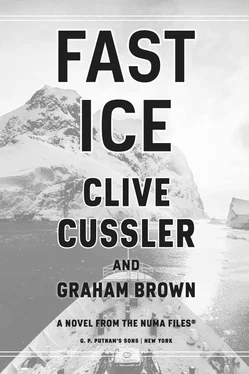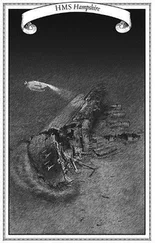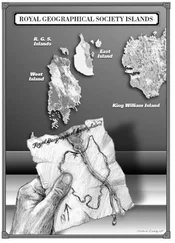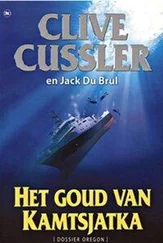While the Russian subs had been loud and easy to track, the Chinese ones were smoother, quieter and covered in sonar absorbing layers of exotic materials. In some cases, they were made of nonferrous metals that made magnetic detection impossible.
The Navy’s response was the radar in the back of Hansen’s P-8. Its beam looked down through the water . It couldn’t detect a submarine directly, but it was so precise it could pick up minute pressure variations caused by a submarine moving through the water, even if that submarine was operating at depths of several hundred feet.
Like surface ships, submarines displaced water as they moved. Only they did so in three dimensions. And while the ocean currents and waves dampened the effect, some of that pressure still reached the surface, forming a barely detectible bulge similar to a ship’s wake that stretched and widened behind the submarine along the path it had just traveled.
The SPS could track the wake, which was like a giant arrow pointing directly to the hidden vessel. And while the system was still being fine-tuned, it had already proven itself in calm weather over moderate seas.
Hansen had been advised to expect more intense trials over the storm-tossed ocean, but no one had said anything about testing it over ice and snow. He couldn’t imagine what the brass was thinking.
“It’s top-level stuff,” he told Collier. “You’re not meant to know. But considering we’ve had to refuel twice just to get here, someone must think it’s worth it.”
“If you say so,” Collier replied. “As far as I’m concerned, some desk jockey at the Pentagon has lost his mind. Either that or he thinks there’s a submarine buried under the snow.”
Hansen laughed at the idea. He did suppose there could be something else of interest down there. “Would the radar find it?” he asked. “If it was there? Can SPS look through snow and ice?”
“Possibly,” Collier replied. “Unlike most materials, water actually becomes less dense as it solidifies. And snow is mostly air gaps. But I doubt we’ll spot anything. The system is dependent upon movement. A submarine keeping station or drifting cannot be detected. So, unless there’s something burrowing under the ice, we probably won’t find . . . um . . . squat, sir.”
Hansen nodded, continued his scan of the instruments and watched as the sun disappeared over the horizon. It was already dark in the frozen land below. Dark and empty. He wondered once more what the Navy was really looking for, then decided he didn’t even want to know.
39
NUMA HEADQUARTERS
Twelve hours later, in a room populated by computers and large screens, Hiram Yaeger and Rudi Gunn were wrestling with the information from the flight.
Studying the screen showing the Great Southern Continent, Rudi saw no sign of a discovery. “Any progress?”
Yaeger adjusted his wire-rimmed glasses and looked up. “We finished downloading the raw data from the Navy. But it’s just that. Raw data. We had to figure out how to work with it, so I ran it through an intense algorithm and assigned values to each of the signal responses.”
“Normally, I’d ask you to spare me the technical mumbo jumbo,” Rudi said. “Since I sense you’re stalling, please do continue.”
“I’m only stalling because even my computers have to manipulate the data before they make something useful out of it,” Yaeger insisted. “Just so you understand, we’re talking billions upon billions of data points here.”
“How long before we see the results?”
“The answer is coming,” Yaeger said, nodding toward tiny red and blue marks appearing in various places on the screen in front of them. “Decision time will soon follow.”
Rudi focused on the screen. At first the tiny marks were scattered, dotting the image here and there like the first drops of rain hitting a dry sidewalk. But as the seconds passed, the minuscule dots began to create a shape, filling in a thin band over which the Poseidon had flown.
“Zoom in,” Rudi said.
Hiram adjusted the resolution and cropped the contours of the map. He continued to adjust the scale until it displayed only the section of land underneath the path of the reconnaissance flight and a small area around the perimeter.
The region in question was thirty miles wide and almost five hundred miles in length. It covered the last-known flight path of Jurgenson’s Dornier. The increased level of magnification revealed thousands of additional marks. Had Hiram continued to zoom in, it would have revealed millions and eventually billions more, each one covering only inches of the Antarctic surface.
As the seconds passed, many of the red and blue indicators changed to gray.
“Are we losing something?” Rudi asked.
“No,” Hiram said. “The computer is normalizing the data. It’s determined that those marks are in tune with the surrounding landform, taking into account snowdrifts, hills and crevasses the way the Navy’s program accounts for waves, currents and tides.”
By the five-minute mark, the search grid was ninety percent gray. Only a mountainous area devoid of snow and a series of thin blue lines, running in haphazard directions, remained colored. “Is that a signal or just noise?”
Hiram leaned forward and studied the data on a laptop directly in front of him. “Hidden depressions in the snow,” Hiram said. “Fault lines in the ice and cracks in the glaciers. Basically, you’re looking at a map of fissures and crevasses. Most of which are probably covered with snow.”
“Make sure you save that data,” Rudi said. “Might come in handy once Kurt and his team are on the ground.”
Hiram nodded and typed an instruction into the computer.
“If the blue dots indicate unaccounted-for microdepressions, what do the red dots tell us?” Rudi asked. “I notice there are fewer and fewer of them as the picture fills in.”
“Red indicates a surface feature out of place with its surroundings,” Hiram said. “There are so few of them because the software blends the surface together and finds a consistent landform. When the Navy uses this, the red points indicate an inconsistent rise in the water level. That’s the signature of the submarine moving toward the sensor. Blue indicates it’s moving away.”
Rudi nodded. If Ryland had built a steel pipeline and buried it under the snow, a long red line would soon appear on the screen. And if he’d used geothermal water to melt a tunnel through the glacier as Kurt suggested, the microscopic settling of the ice above it would become noticeable as a thin blue streak.
The truth finally appeared. A long blue line that led directly to the sea. With only a single red area at its origination point.
“Nothing in nature draws a perfectly straight line,” Rudi insisted.
“There are two small detours,” Hiram pointed out, “but they’re consistent with a canal or a pipeline dodging around mountainous terrain.”
“The line stops about twenty miles from the ocean,” Rudi said. “If it is Ryland, does that mean he’s not finished?”
“Impossible to tell,” Hiram admitted. “The line terminates near a glacial fault zone. Might mean they ran into problems. Or they might have found a meltwater route directly to the bay.”
“Meaning they could already be pumping the algae.”
Yaeger nodded.
“Worst-case scenario,” Rudi said. “Antarctic glaciers in the twilight of the southern summer would be at maximum melt-off.”
“He’s thought this through,” Hiram said. “I’ll give him that.”
“We’re going to stop him. Stop him at the source,” Rudi said. “Precisely as Kurt envisioned in the first place.”
“Which source?”
Читать дальше












